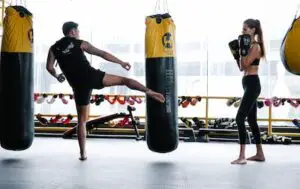Kung Fu is a popular Chinese martial art that has been practiced for centuries. It focuses on both physical and mental techniques, including hand poses that are used to attack and defend. Hand poses, also known as hand shapes or hand forms, are essential in kung fu as they help to enhance the effectiveness and power of a practitioner’s martial arts movements.
In this article, we’ll explore the different hand poses for kung fu styles, how they are used, and their key benefits. We’ll also answer some frequently asked questions about kung fu hand poses.
What are the different hand poses for kung fu styles?
Kung Fu is a diverse martial art that encompasses many different styles and techniques. Each style has its unique set of hand poses, which can vary depending on the particular movement or attack being performed. Here are some of the most common hand poses found in kung fu:
The Iron Fist: Also known as the One Finger or One Knuckle Fist, this pose is formed by tightly closing the hand with the thumb on top of the index finger, leaving the rest of the fingers extended. It is used for striking, breaking objects and can deliver a powerful punch.
The Leopard Paw: This hand pose is used in the Five Animals style of kung fu. It involves curling the fingers towards the palm and extending them slightly. The fingers are then thrust out to strike the opponent’s pressure points, causing pain and disabling movements.
The Eagle Claw: This hand pose is used in Eagle Claw kung fu and involves extending the fingers in a claw-like shape, with the tips of the fingers bent towards the palm. The Eagle Claw can be used for grabbing, squeezing, and pinching.
The Dragon Claw: This hand pose is used in Dragon style kung fu. It involves making a fist with the thumb tucked into the palm, and the fingers extended and bent slightly. This pose is used to strike and grasp opponents’ limbs, which can be effective in disabling and taking down opponents.
The Phoenix Eye Fist: This hand pose is formed by wrapping the index finger into the palm and gripping it with the other fingers. It is used in Wing Chun style kung fu and is an essential tool to attack the opponent’s eyes or other sensitive areas.
The Snake Hand: This hand pose is used in Snake style kung fu. It involves forming a fist with the index and middle fingers extended and close together, resembling a snake’s fangs. The pose is used to attack the opponent’s vital points with quick, coordinated strikes.
What is the significance of hand poses in kung fu?
Hand poses are an essential part of kung fu as they help to enhance the power and effectiveness of martial arts movements. Each hand pose is created to intentionally strengthen and enhance certain parts of the hand, fingers, and wrist, allowing for a better strike or more substantial impact.
For example, the Iron Fist is useful for breaking objects, such as wood or bricks, as it concentrates the striking force onto a small surface area. Similarly, the Dragon Claw is used to grab and hold onto the opponent’s limbs, allowing for more extended control over the opponent’s movements during a fight.
Hand poses are also used to target specific pressure points, allowing kung fu practitioners to strike specific parts of the opponent’s body with precision to cause pain and disable movements. The Leopard Paw is an excellent example of this, as it can be used to strike the opponent’s pressure points on and around the neck and head, causing pain and immobilizing the opponent.
Overall, hand poses in kung fu are essential because they enable practitioners to use their entire body in martial arts movements. They help to create a seamless flow of energy and allow movements to be more effective and powerful.
How do hand poses benefit kung fu practitioners?
Hand poses in kung fu offer several benefits to practitioners. Firstly, they help to develop strength in the hands, fingers, and wrists, which is essential for executing powerful strikes and movements. As a result, regular practice of hand poses can improve grip strength, dexterity, and overall hand coordination.
Secondly, hand poses are also useful in enhancing flexibility and joint range of motion, which is critical for executing various strikes and achieving success in kung fu.
Thirdly, by focusing on hand poses, kung fu practitioners develop a deeper understanding of the martial art’s principles and techniques. The poses help to emphasize the different types of strikes, movements and their intended purposes, ensuring that practitioners can execute them effectively in real combat situations.
What are some key tips for learning hand poses in kung fu?
Learning hand poses in kung fu takes a considerable amount of practice and effort. Here are some tips that can help you learn hand poses successfully:
Practice regularly: Regular practice of hand poses is essential to build muscle memory and to increase flexibility and strength. Make sure to dedicate a few minutes each day to focus on hand poses and other kung fu techniques.
Use a mirror: Using a mirror to practice hand poses can be helpful in ensuring that the form is correct. Look at yourself in the mirror and try to maintain the right position and alignment of fingers and knuckles. This will help you develop and maintain the correct form and prevent potential injuries.
Seek guidance: It is always helpful to seek guidance from a qualified kung fu instructor when learning hand poses. They can provide you with real-time feedback on your form and help you improve your technique.
What are some common mistakes to avoid when practicing hand poses?
Learning hand poses can be challenging, and it’s essential to be aware of common mistakes to avoid injury and maximize effectiveness. Here are some common mistakes to avoid:
Inadequate practice: Inadequate practice can cause injury and prevent you from mastering hand poses. Ensure that you practice regularly to build up your strength and flexibility.
Incorrect form: Incorrect form is common among beginners learning hand poses. Ensure that you follow the correct form so that you can execute the poses correctly.
Too much focus: Avoid focusing too much on the hand poses during sparring or combat situations. Instead, shifts your focus to the overall situational awareness and technique you are trying to use.
What are some effective kung fu hand poses for self-defense?
Kung fu hand poses can be effective tools for self-defense. Here are some hand poses that are useful in self-defense situations:
Iron Fist: The Iron Fist is powerful in punches, breaking, or striking objects. It can be used to deliver a strong punch that stuns or knocks an attacker out.
Leopard Paw: The Leopard Paw is useful in targeting the opponent’s pressure points and can cause intense pain and disruption of movement.
Phoenix Eye Fist: This hand pose is excellent for attacking the opponent’s eyes or other sensitive areas.
Eagle Claw: The Eagle Claw can be used to grab, squeeze, and pinch an opponent, causing intense pain and immobilizing them.
Conclusion
In conclusion, if you’re practicing kung fu, learning hand poses is essential as they are an integral part of martial arts movements. Remember to practice regularly, seek guidance from a qualified instructor, and focus on proper form to maximize your effectiveness. With consistent practice and dedication, you can master hand poses in kung fu and become a skilled martial artist.





